|
 Heart Health and Juice Plus+ Heart Health and Juice Plus+
 The
American Heart Association recommends eating eight or more fruit and vegetable
servings every day. An average adult consuming 2,000 calories daily should aim
for 4.5 cups of fruits and vegetables a day. Also, variety matters, so try a
wide range of fruits and veggies. The
American Heart Association recommends eating eight or more fruit and vegetable
servings every day. An average adult consuming 2,000 calories daily should aim
for 4.5 cups of fruits and vegetables a day. Also, variety matters, so try a
wide range of fruits and veggies.
On her "The Heart of the Matter" DVD (below), Dr. Tamara Sachs (Internal Medicine) discusses her
professional experience with heart disease. She says:
"Health is more than the absence of disease: it is a balance between wellness and the many
stressors in your life. The more active a participant you are in this dynamic process, the healthier a person you will
become."
"Knowing what you need to do and actually doing it are two different things. Juice Plus+ is a
perfect example. Knowing that we should eat more fruits and vegetables is one thing, but actually doing it is quite
another. That's why I recommend Juice Plus+ to all of my patients. It is a powerful and compelling product for those who
wish to protect their health. I would never want to be without it. It is my foundational product for my patients, and I
rely on it for my health as well."
Here are the abstracts of
6 studies which demonstrated significant improvement in markers of
heart health for those taking Juice Plus+, including reduction in homocysteine, systemic inflammation
and the negative effects of a high fat meal
(watch the video!)

University of Maryland School of Medicine
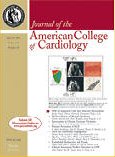 Plotnick et al. Journal of the American College of Cardiology 2003 Plotnick et al. Journal of the American College of Cardiology 2003
Thirty-eight healthy American volunteers
took part in the study. Subjects were randomized groups to take Juice Plus+
Orchard Blend and Garden Blend, Juice Plus+ Orchard Blend, Garden Blend and
Vineyard Blend, or placebo daily for 28 days.
A high fat meal caused a temporary
deterioration of artery function in people taking a placebo – the arteries
weren’t as flexible.
However, the combination of Juice Plus+ Orchard,
Garden and Vineyard capsules virtually eliminated these negative cardiovascular effects, helping the study subjects to respond to changes in blood flow.

Vanderbilt University School of Medicine
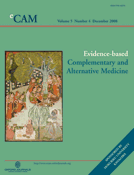 Houston et al.
Journal of Evidence-Based Complementary and Alternative Medicine
2007 Houston et al.
Journal of Evidence-Based Complementary and Alternative Medicine
2007
Juice Plus+ consumers monitored over two years showed improved systemic blood pressure and large
artery compliance; improved glycated hemoglobin; improved antioxidant status; improved homocysteine; less than expected
progression of coronary artery calcium score; and, no adverse side effects.
Researchers followed 51 hypertensive (on stable medication) and pre-hypertensive adults asymptomatic
for heart disease over two years taking Juice Plus+ Orchard, Garden and Vineyard Blends. The participants were primarily
male (80%) with an average age of 61 years. They followed their habitual diet, exercise program, and other lifestyle
behaviors and experienced no change in body weight. By the end of follow-up, both systolic and diastolic blood pressure
decreased; large artery compliance improved; and, progression of coronary calcium score was smaller than expected. Folate, beta-carotene, Co-Q10, and alpha-tocopherol increased. Both
glycated hemoglobin and homocysteine decreased.
Complete Article:
eCAM 2007

University of Sydney in Australia Study
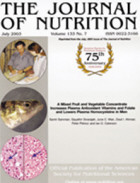 Samman
et al. Journal of Nutrition 2003 Samman
et al. Journal of Nutrition 2003
When compared to placebo, Juice Plus+ increased plasma levels of important antioxidant nutrients,
folate, and a functional measure of plasma antioxidant capacity, while effectively decreasing homocysteine, an
established risk factor for CHD.
This study measured the effect Juice Plus+ on plasma levels of selected vitamins, recognized coronary
heart disease (CHD) risk factors, and general antioxidant status. Thirty- two healthy Australian men participated in
this double-blind, placebo-controlled randomized crossover trial, consisting of two intervention periods of six weeks
each, separated by a three week wash-out phase. During the intervention periods, subjects took either Juice Plus+ or
placebo. Blood samples for nutrient analysis of and plasma antioxidant capacity were obtained at baseline, and again at
the end of the third and sixth week for each intervention period. Plasma folate, vitamin C, alpha-tocopherol (vitamin
E), retinol, and beta-carotene all increased significantly during the Juice Plus+ intervention period compared to
placebo period. There was a trend (p = 0.065) for increased plasma antioxidant capacity, and a significant reduction in
homocysteine during the Juice Plus+ intervention period.
Complete Article:
Journal of Nutrition 2003

Tokyo Women's Medical University
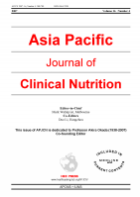 Kawashima
et al. Asia Pacific Journal of Clinical Nutrition 2007 Kawashima
et al. Asia Pacific Journal of Clinical Nutrition 2007
When compared to placebo, Juice Plus+ effectively increased plasma levels of important antioxidant
nutrients and folate and reduced homocysteine.
This study compared the effect of Juice Plus+ or placebo on plasma levels of various micronutrients.
This investigation had a randomized double-blind, placebo-controlled design and included 60 healthy Japanese men and
women, with an average age of 27.8 years. About half of these study subjects were smokers. The study subjects took
either Juice Plus+ or a placebo for 28 days. Concentrations of the carotenoids beta-carotene and lycopene, vitamin E and
folate significantly increased while homocysteine and lipid peroxides were significantly decreased in the Juice Plus+
group over this study period.
Complete Article:
Asia Pacific Journal of Clinical Nutrition 2007

Foggia Italy
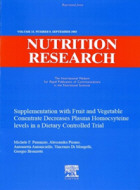 Panunzio et al. Nutrition Research 2003 Panunzio et al. Nutrition Research 2003
The daily use of Juice Plus+ for four weeks increased folate and decreased homocysteine concentration
in healthy Italian volunteers.
This study showed Juice Plus+ use led to a reduction in plasma homocysteine concentration. Twenty-six
healthy Italian subjects (12 men and 14 women) aged 20-56 years, took part in this randomized, crossover study. The
trial was separated into three phases of four weeks each: an initial treatment period, a washout period and a second
treatment period. Folate level increased and homocysteine level decreased significantly in both groups while taking the
Juice Plus+ capsules, but not during the control period of this study.
Complete Article:
Nutrition Research 2003

University of South Carolina
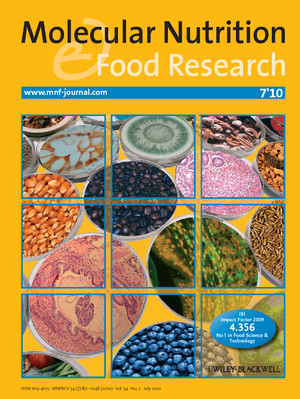 Jin
et al. Molecular Nutrition & Food Research 2010 Jin
et al. Molecular Nutrition & Food Research 2010
When compared to placebo, Juice Plus+ effectively reduced markers of systemic inflammatory load,
increased plasma levels of important antioxidant nutrients and increased the antioxidant enzyme superoxide dismutase.
The researchers studied the impact of Juice Plus+ Orchard and Garden Blend, taken alone and in
conjunction with Juice Plus+ Vineyard Blend: a) on levels of several important free radical-fighting antioxidants in the
blood (as an indication of bioavailability); b) on levels of superoxide dismutase, an antioxidant enzyme that helps rid
the body of free radicals; and c) on levels of several key biomarkers of systemic inflammation.
Acute inflammation - the red skin around a cut, for example - is a normal protective response by tissues throughout the
body to injury or destruction. However, chronic systemic inflammation is invisible, and can contribute to an increased
risk for developing chronic conditions associated with premature aging such as cardiovascular disease, diabetes, and
cancer. The South Carolina researchers hypothesized that added nutrition from fruits and vegetables - delivered in the
form of Juice Plus+ - could positively impact biomarkers of inflammation in the blood.
In their recently published paper, the USC researchers reported: a) significantly increased levels of all three
antioxidants (vitamin C, vitamin E, and beta-carotene) in both groups of Juice Plus+ groups, compared to placebo; b)
significantly increased levels of superoxide dismutase in both groups; and c) significantly decreased levels of three
key biomarkers of inflammation in both groups.
Article Abstract: Molecular
Nutrition & Food Research 2010
You can learn more about Juice Plus+ and the medical research behind it
here.
Why not choose to make your heart healthier every day?
You can learn more by watching Dr. Sachs' video below.
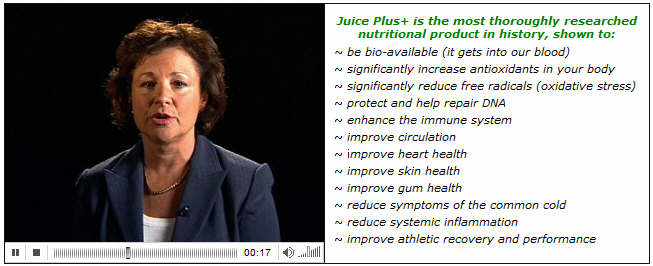 |
 Jin
et al. Molecular Nutrition & Food Research 2010
Jin
et al. Molecular Nutrition & Food Research 2010 Heart Health and Juice Plus+
Heart Health and Juice Plus+ The
American Heart Association recommends eating eight or more fruit and vegetable
servings every day. An average adult consuming 2,000 calories daily should aim
for 4.5 cups of fruits and vegetables a day. Also, variety matters, so try a
wide range of fruits and veggies.
The
American Heart Association recommends eating eight or more fruit and vegetable
servings every day. An average adult consuming 2,000 calories daily should aim
for 4.5 cups of fruits and vegetables a day. Also, variety matters, so try a
wide range of fruits and veggies.




